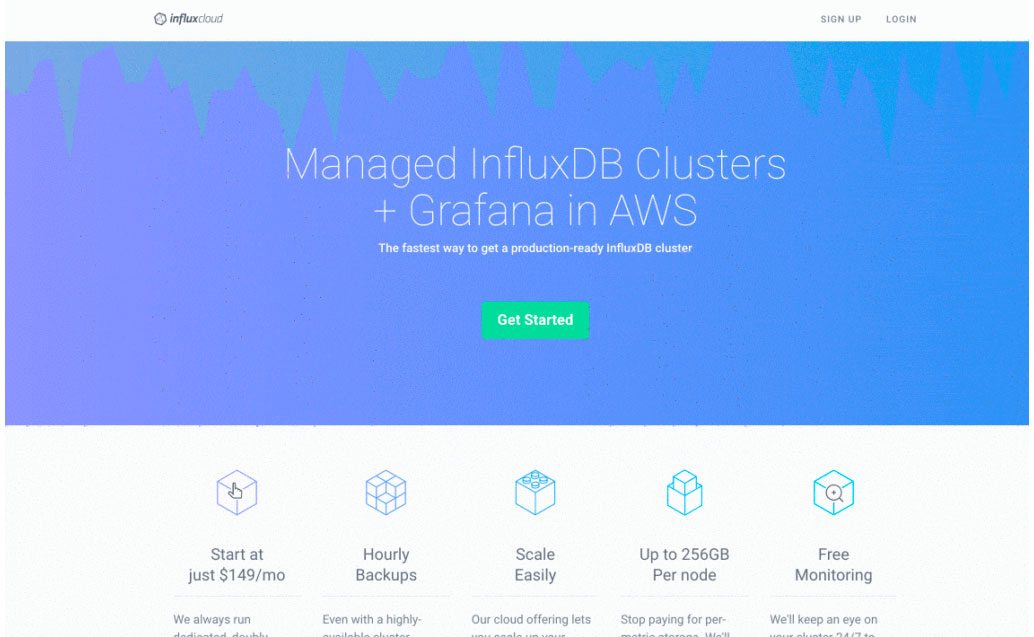Announcing InfluxDB Cloud - Fully Managed InfluxDB Clusters on AWS
By
Paul Dix
Product
Company
Press Releases
Apr 19, 2016
Navigate to:
Today we’re excited to announce the immediate availability of fully managed InfluxDB clusters on AWS! This is the fastest way to get a highly available, scalable InfluxDB cluster up and running. We’re launching in all of Amazon’s US and EU regions with storage sizes ranging from 16GB to 256GB (larger setups are available by contacting sales). Plans start at just $149 per month with a 20% discount if you commit to a year up front. Read on for more details or sign up and get your cluster up and running in just a few minutes!

Cluster architecture
The InfluxDB Cloud service manages and distributes data and queries to a number of InfluxDB servers we call Data Nodes. We handle all consensus and coordination for you behind the scenes. As a user you’ll get a single Elastic Load Balancer endpoint to write and query data from.
With an ELB it means you won’t have to worry about failing over to another server, it’ll happen automatically. Retry logic within your client should be enough to give you a highly available setup.
Most of our offerings have two Data Nodes so our users can create retention policies with a replication factor of two to ensure they’re up and running even if one of the nodes goes down. The largest configuration gives the user four Data Nodes with a replication factor of two to split data across.
Later this year we’ll offer multi-region clusters and replication. (Contact sales if you’d like to learn more about availability.) At launch time clusters are a fixed size, but the functionality to scale out a cluster will be added automatically in the coming months. This means you’ll be able to add Data Nodes to your configuration as needed to scale out to meet your storage or throughput needs.
Which configuration is right for me?
At first glance, it’s hard to know what the various cluster sizes mean, so we’ll give a little guidance here. We split the configurations out based on the amount of storage and memory on each Data Node. Memory is important for use cases with many unique series, while storage is important based on the total volume of data (regardless of the number of series).
We also tested throughput with our stress tool. By batching up writes into single requests, we saw throughput of up to 5,000 values per second on the smallest cluster and up to 50,000 values per second on the largest.
If you’re unsure what size to pick or need more guidance please contact sales and we can get you connected with a solutions architect who can help you size the proper configuration for your workload.
Sunsetting our Digital Ocean offering
For existing customers of the InfluxDB Managed Hosting service on Digital Ocean, we’ll be sunsetting the service at the end of 2016. If you are currently a customer of the Managed Hosting service, we’ve got a special offer for the next 45 days exclusively for you. Sign up for a year and you’ll get an additional 10% off the annual price of both the hosting and technical support fees. Just email our Sales team to get the promo code, and then signup here and select annual billing. Once you’ve completed the signup process, the InfluxDB Support team will work with your team to get your data migrated to the InfluxDB Cloud service on AWS. For our existing customers that are uninterested in moving to AWS, we’ll provide you with tools to easily get all of your data from your server.
What's next?
- Get started with fully managed InfluxDB Clusters on AWS by signing up here.
- Need help migrating from 0.8x or 0.9x to 0.12? We are here to help! Drop us a line at to get your migration project started.
- Looking to level up your InfluxDB knowledge? Check out our FREE and economically priced virtual and upcoming public trainings in SF and NYC.
